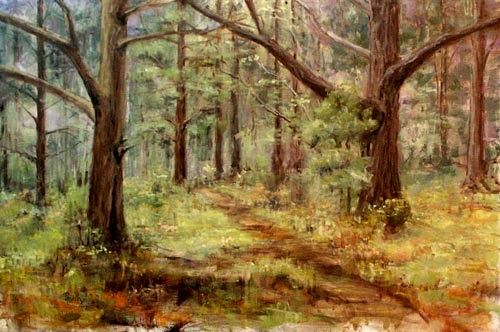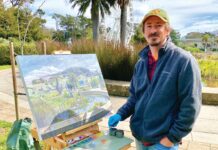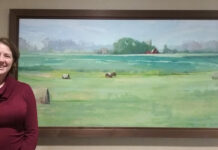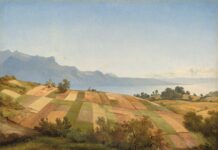
Bill Guffey‘s favorite place to paint is man-made, but it’s wild and natural. It’s in farm country, but it’s public property. It’s scenic in the height of summer and at the nadir of winter.

Guffey’s setup for “Landscape at Dale Hollow”
“You know how it is when you go out painting — you want to paint water,” the Kentucky artist begins. “There are plenty of streams and shorelines at this spot. It’s mostly farmland around here, but I want to make sure I have permission to be somewhere so I don’t get shot or chased by a bull. So I go to Dale Hollow Lake State Resort Park.”

“Beyond the Cedar,” by Bill Guffey
The lake is a reservoir, formed by a dam on the Obey River, and it’s situated on the Kentucky-Tennessee border. The 27,700-acre lake is surrounded by 24,800 acres of park land. “It’s convenient and beautiful,” says Guffey, who lives less than 10 miles away. “There’s a lot of coastline and horse trails. It’s really steep and hilly. It’s just hills and hollers that were filled up with water after they built the dam. I usually end up somewhere along the shore in the woods, so I get a little bit of the lake in it.”

Guffey’s setup for “Beyond the Cedar”
One of his favorite spots is Eagle’s Point, which requires a hike 400 feet nearly straight down to the shoreline. “The geography of the land around here is cliffs and bluffs,” says Guffey. “We’re in the Appalachian foothills.” The artist is a devoted painter, racking up 34 paintings in August alone — and that’s with a full-time job at a newspaper and a family to consider. “I’ve painted in 100-degree weather and temperatures below zero, with icicles hanging off the corners of my moustache,” he says. “I’ve painted more than 230 paintings this year. They add up pretty quickly if you go out every day or every other day. Going out there has really helped me grow in the studio.”

“I Went to the Woods,” by Bill Guffey, oil, 16 x 20 in.
Inside, Guffey’s work often takes on an abstract quality. This is in part because of his study last summer of the work of Richard Diebenkorn. He uses satellite images to paint the view of farms from above — high above. “Diebenkorn totally turned my world upside down,” says Guffey. “He really turned me around, and now I am able to see shapes and I can take that outside and use that ability to see more.”

“Misty Trail,” by Bill Guffey, oil, 18 x 24 in.
Guffey only started painting seriously in 2008, but now he paints before work, after, and at lunch, his trusty Gloucester-style easel always ready for service.

“Creek in Winter Light,” by Bill Guffey, oil, 24 x 18 in.
Dale Hollow Lake offers an abundance of subject matter, and Guffey expands the options even further by moving elements around to please him, or by adding colors that aren’t in the scene. Kentucky is very green in the summer, so he makes a point of mixing his greens to carefully neutralize them and to give them a wide variety of hues. He tones his surface and lets some of that warm color show through. Motifs of spectacular beauty are not necessarily his preference; Guffey is looking for interesting design. He has his favorite motifs, though. “There are a couple of trees — oaks and cedars — that I swear I’ve painted 10 or 15 times,” he says. “They are my tree friends. But I will switch things up, put a new color in there.”

“Farmland No. 53,” by Bill Guffey, oil, 36 x 24 in. Studio work inspired by satellite image
Summer in Kentucky is wonderful, but the green can fatigue a painter. Guffey is not immune to this. “I really look forward to fall and winter; it gives me a little different color to work with,” he says.




